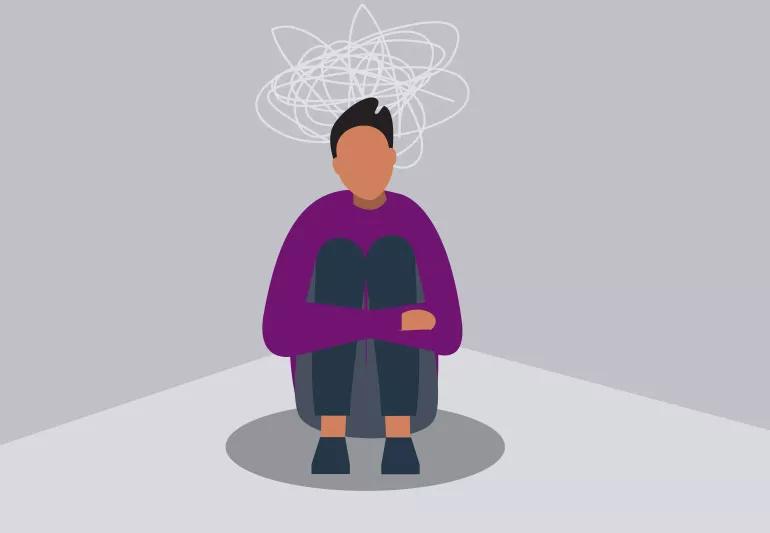A guided process of connecting current feelings to past events

Now, more than ever, it’s not unusual to experience a wide range of emotions, especially anxiety. And dealing with anxiety can feel like an uphill battle that never ends. That constant gnawing feeling of stress, of worry, can attach itself to you and dominate your life and your well-being.
Advertisement
Cleveland Clinic is a non-profit academic medical center. Advertising on our site helps support our mission. We do not endorse non-Cleveland Clinic products or services. Policy
There are a number of excellent treatments for anxiety but one that deserves a fresh, new look is hypnotherapy. While the presence of the word “hypnosis” may trigger skepticism in the minds of some potential patients, hypnotherapy is a safe, guided experience that involves intense concentration, and focused attention to gain insight regarding how past experiences, emotions and traumas play a large role in creating behavioral patterns. Often, these factors also create limitations to successful relationships, careers and overall life satisfaction.
We spoke with holistic psychotherapist Maura Lipinski, LISW-S, to better understand the process of hypnotherapy, how it alleviates anxiety and to learn about the misconceptions that might prevent patients from exploring this safe, effective form of therapy.
For Lipinski, the hypnotherapy approach begins by looking at the conscious, subconscious and unconscious mind.
“The conscious mind, according to Freud, includes thoughts, sensations, and feelings that we are aware of and can easily access and analyze,” she says. “The conscious mind is sometimes considered to be the part of our mind where we reason.”
Continuing debate exists related to the terms “subconscious mind” and “unconscious mind,” she adds. Both terms have been used in the field to include the idea that many feelings and painful memories are repressed or suppressed, typically in childhood. And these same feelings and memories create challenges in our psychological state. These challenges can develop at the time of trauma or much later in life after the adverse event.
Advertisement
In Freud’s model the subconscious and unconscious levels are similar, but the unconscious level is seen as the deepest level, and includes deep-seated emotions and trauma, whereas the subconscious holds thoughts, behavior patterns and emotional information that is more readily accessible. The subconscious is seen as more of a gateway between the conscious and unconscious levels.
“For our purposes,” Lipinski says, “we focus on the subconscious or unconscious information that is driving current responses in the background like a computer drive.”
With hypnotherapy, she points out, the process begins by looking at the present emotion which would usually be among the core emotions: fear, anger, sadness, guilt or shame. And anxiety, Lipinski says, exists on that fear spectrum.
Even if it’s a free-floating anxiety, a term currently being used to explain the feeling of anxiety that a client has without a connection to a particular stressor, Lipinski says the next step is to explore if that anxiety is also linked to an incident in the past. “Does it go back to something from earlier in life? What did the patient conclude or decide after experiencing it? How is that conclusion being acted upon today in their current circumstances subconsciously or unconsciously?”
“It’s not that the anxieties that are happening today aren’t real. They are,” she says. “But the response to it might go back to third grade, where we made a decision or a conclusion about ourselves with the thinking of a third-grader, with a more concrete mind and in many cases, the third grader did not have emotional support from an adult or did not know how to access that support. And sometimes that third grade conclusion is what gets subconsciously pulled forward, causing us to operate from that historical place.”
Lipinski says, hypnotherapy starts with guided imagery to help the patient enter a more relaxed state. But, she adds, this is an interactive process and the client maintains awareness during the session and memory of the session following it.
Once in a relaxed state, the patient is guided to begin connecting the current stressors with feelings from the past. “It’s a process that allows patients to gain different insights about what’s fueling their behavior,” Lipinski says. “And that can help them to process the suppressed or older emotions and change the negative subconscious or unconscious thoughts that they’re having about themselves or their life circumstances.
With this in mind, Lipinski says, “A lot of our therapeutic work tends to be in the place of mindfulness, looking at the content and language of our thoughts. We have control over how we think, just as we have control over how we speak. We can take negative thoughts that we are having and change the words of those thoughts to something healthier. And then our emotional experience follows the thoughts, allowing us to experience more balanced emotions.”
Advertisement
She says that her role for the most part, isn’t to send the patient back to a specific time in their life, although this can be a part of hypnotherapy, Rather, it’s to guide the patient back to a time when they previously felt similar emotions as they are feeling in the present.
“You have memories about events from certain ages in your life. Hypnotherapy helps people to connect the feelings and experiences of our child selves to our more complex understanding that is available with our adult minds. This, in turn, can help to resolve feelings of powerlessness from childhood and allow people to make healthier decisions in the future,” Lipinksi says.
The process, she says, honors where each client has been in life and how their own resilience can help them with what’s happening in the present.
Lipinski stresses the differentiation between hypnosis and hypnotherapy. “Hypnosis is a method characterized by providing relief from symptoms through a relaxed state and post-hypnotic suggestion,” she says. “Hypnotherapy is an interactive therapeutic process using hypnosis and techniques from other therapy models, such as cognitive therapies, somatic theory, mindfulness and inner child/wise adult work.”
Advertisement
Hypnotherapy is provided by a licensed therapist with specialized certifications and is focused on the client and therapist discovering the root cause of anxiety and other emotional challenges. In society, there is often a pop-culture view of using hypnotic suggestions for comedy purposes or mind control purposes. This is the definitive opposite of how hypnosis is used in the hypnotherapy setting.
“Before a patient begins the process,” according to Lipinski, “a full mental health evaluation is completed and treatment goals are set with the client.”
Clients benefit from hypnotherapy by exploring what roles that they have taken on in life, (beginning in their family of origin), and this type of therapy empowers them to gain self-awareness and healthy boundaries with others and themselves. In doing so, they report feeling less anxious and more connected to their own goals and purpose. It’s a supportive, effective and safe method. Emotional safety tools are built into the model, including the patient’s option to stop the process at any time.
While there are a number of therapy styles available to patients, Lipinski says that a few factors in favor of hypnotherapy are the client’s reports of its effectiveness. “Hypnotherapy can target the emotional blocks or natural resistance that we have in our subconscious/unconscious minds. Connecting with our true healthy power and learning new skills to manage and let go of emotions, is a strong weapon against anxiety.”
Advertisement
“The bigger gain for clients is that they are walking around feeling different about themselves,” she continues. “There’s an integration that happens with this model where the client is responding to things from a more confident, calm place. There is behavioral change, but more importantly, there is a self-esteem change. This calmness carries over into their family life, their work life and their passions or interests.” “The process can be very empowering,” she says. “And it’s especially helpful in reducing anxiety.”
Learn more about our editorial process.
Advertisement

Learn about hypnotherapy and how it can compliment your training regimen

When the drive is familiar or monotonous, ‘procedural memory’ can take the wheel

Use the power of suggestion to change your thoughts, emotions and behaviors

Acupuncture, herbs and hypnotherapy curb cravings naturally

Most recommended precautions center around minimizing bruising or swelling

Even one drink can have an impact on your cognitive function leading to slurred speech, blurred vision and impaired memory

Type 2 diabetes isn’t inevitable with these dietary changes

Applying a hot or cold compress can help with pain